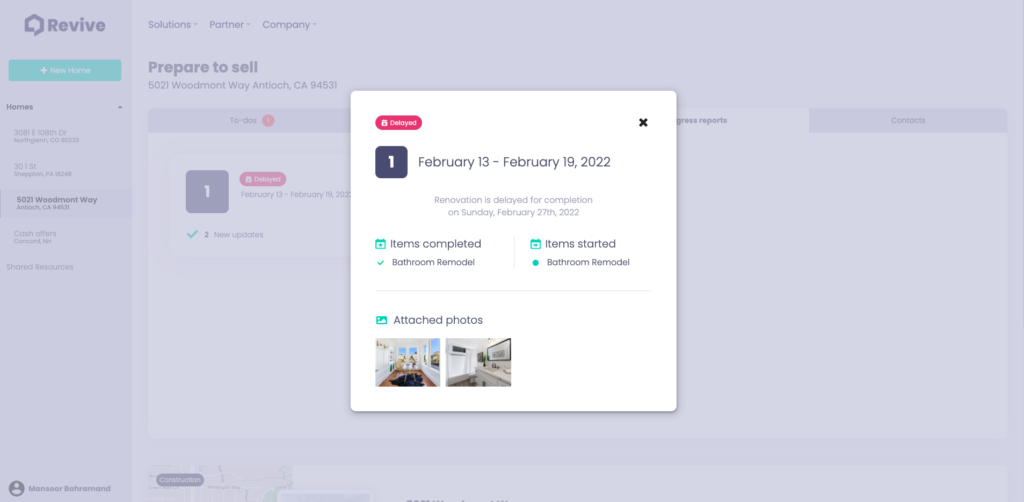Revive software helps agents, sellers and contractors determine a budget and manage small presale home renovation projects. Inman’s tech expert Craig Rowe offers pros and cons.
Revive is software to help coordinate home renovations and pre-market upgrades. It also has a ‘buy-before-you-sell’ program.
Platforms: Mobile app; browser app
Ideal for: Agents, sellers, contractors
Top selling points:
- Personal advisers backing software
- Property Page dashboard
- Collaboration with multiple stakeholders
- Bases project cost/value on local comps
- Heavy emphasis on project deadlines
Top concern:
Revive is up and running well in California’s Bay Area, largely because of solid local contractor relationships. That could become an issue when scaling to tertiary or midsize markets around the country.
What you should know
Revive gives sellers a clear financial look into what a home may be worth after a renovation or room refresh before selling. The software uses different user views and tools for sellers, agents and contractors. Renovation plans are assembled by Revive staff who use localized market data and previous projects to arrive at estimates and work with contractors.
Revive isn’t leaning entirely on software to automate what is obviously a very hands-on process. It instead blends its technology with salaried advisers assigned to each agent’s needs upon setup. Another touch I like is its use of video explainers at major steps along the way.

Agents are tasked with inviting their seller to the system, entering the listing information and choosing a few comps that will be used by Revive throughout the relationship.
The property page is a clear, engaging breakdown of everything that’s happening, categorized by each property in the program. It can include uploaded listing agreements and other documents critical to the transaction, even some basic buyer financial confirmations, such as current mortgage debt and equity.
Revive’s advisers will offer up a renovation budget based on what’s being done, such as new kitchen, new primary bath or carpets and paint. While it’s possible, Revive isn’t about managing large, multi-month home renovations. These are meant to be smaller in scope, high-quality turnarounds that are proven to maximize return in most cases.

Revive puts a clear emphasis on project delivery once underway, carefully vetting contractors according to their ability to communicate clearly and interact with all parties through the software. One way it ensures interaction is by tethering the contractor’s location to the project using a mobile device’s geo-location tools.
Once on-site and after they’ve left, Revive sends notifications for them to upload images and video of progress and input data on progress, what’s been completed and how that impacts the current deadline.
Another way Revive helps ensure things get done as expected is by linking contractor pay directly to their ability to finish on time.

Now, I’m all for accountability, but as someone in the middle of a renovation project at the moment, I simply can’t see this model being tolerated by many contractors, not without some room to breathe, at least.
For example, my city messed up the water connection from the street to the house, making it impossible for my contractor to turn off water to the house before we can pull out the shower without risking a pipe break. If I tried to tell my contractor I’m going to dock him pay because of this, I’d be faced with finding a new contractor. Which would grow increasingly difficult because these guys all know each other, even in bigger cities. When subs and materials vendors start to get involved, delays are common and hard to predict.
Revive has overcome this in its base city of San Francisco by finding a few good teams and sticking with them. I was told in our demo that only six different contractors have handled more than 40 projects for their clients. This is good and bad. All parties have a dependable counterpart to work with on their home re-do, but it also shows how Revive’s model limits who it can hire. At least for now.

All said, Revive’s software looks great and its functionality is right where it should be as a middle-point for all the people and tasks involved in getting a home ready for the open market. Each party has its own entry points and features, and once a project is underway, everyone knows what’s happening. When needed, agents can channel conversations strictly with contractors or their buyers.
On that note, the company is very close to launching a refreshed mobile experience that will be able to contain the entire project management workflow in a text-based mobile experience, making it faster to access and that much easier to communicate. I was only provided a few screenshot renderings but was told it’ll be ready soon.

I should note that Revive also offers consumers a cash-based, buy-before-you-sell program. This allows a seller to find a new place with a contingency-free cash offer, then approve renovations for the previous home before it hits the market. So, something else to consider.
Revive recently hooked up with zavvie, which thrives in the multiple offer comparison space. It’s a smart partnership.
In this market, a new kitchen or better-looking interior can do a lot for a listing. Given the market’s ongoing conditions, it doesn’t look like sellers have to hurry.
Have a technology product you would like to discuss? Email Craig Rowe
Craig C. Rowe started in commercial real estate at the dawn of the dot-com boom, helping an array of commercial real estate companies fortify their online presence and analyze internal software decisions. He now helps agents with technology decisions and marketing through reviewing software and tech for Inman.
















Comments